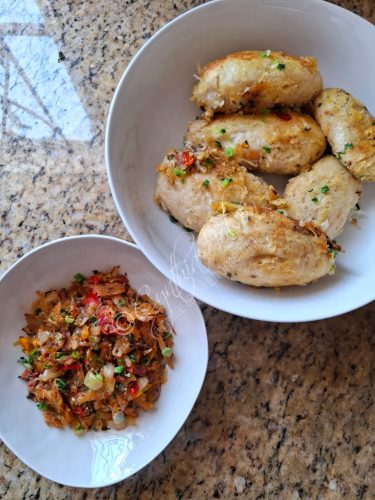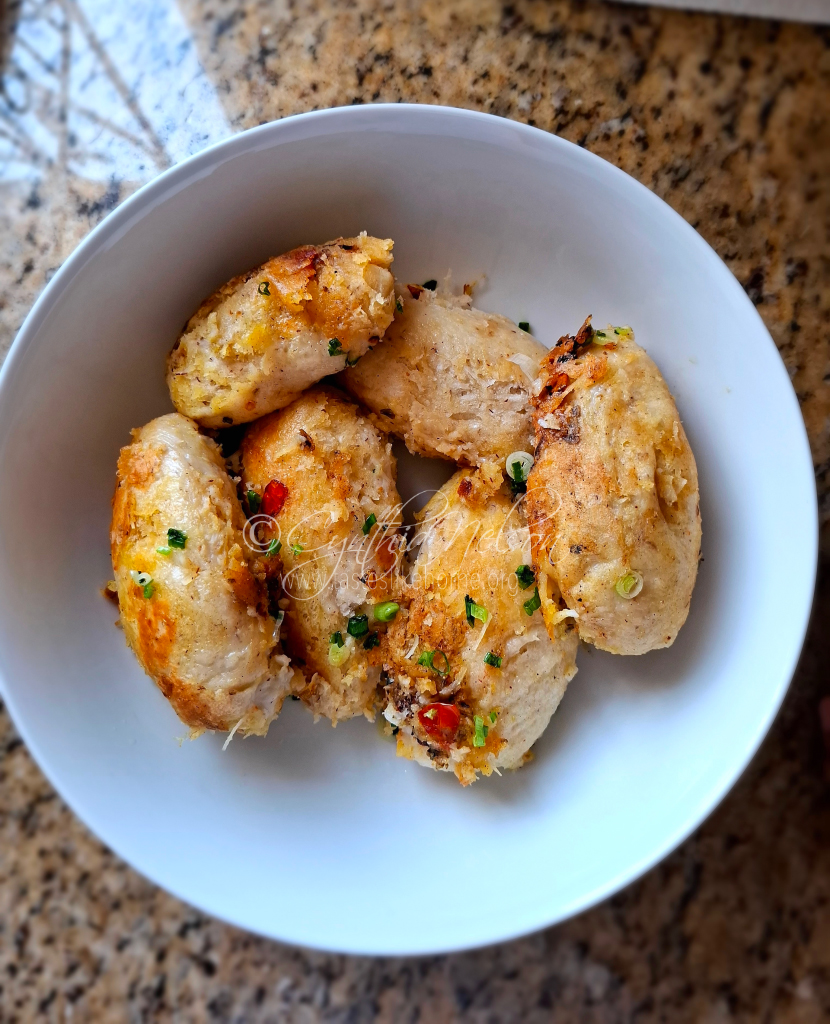Listen to this article:
Audio Player Soft, tender, and fluffy with a hint of sweetness – that is the sum of Duff. Have you ever eaten something that you have not had in ages? I am talking years here, and have you wondered why you don’t make it more often? That’s what I asked myself last weekend when I decided to make some Duff with fried salt fish.
Soft, tender, and fluffy with a hint of sweetness – that is the sum of Duff. Have you ever eaten something that you have not had in ages? I am talking years here, and have you wondered why you don’t make it more often? That’s what I asked myself last weekend when I decided to make some Duff with fried salt fish.
When last have you had Duff?
Reserved mostly for dishes like Metemgee (the one-pot dish of ground provisions cooked in fresh coconut milk) and boil ‘n fry ground provisions, Duff is the kind of dumpling that feeds the soul. It is simply comfort food. The comfort does not only come from how it makes you feel, but the descriptors exude comfort – soft, tender, fluffy. See?

There are certain things in life that every time you engage with them, they reveal more of themselves. There are layers (metaphorically speaking). There is more to understand, more to appreciate, more to learn, more to create and more to discover. It is one of the many ways in which I think of the food of Guyana. The diversity, range, and variety is something to be in awe of. And then there are multiple ways to experience and enjoy the food depending on the skill of the cook, each with their unique way of doing things. It is an endless buffet of creativity and deliciousness.
There are many Guyanese foods that I learned to make after I moved abroad. In some ways, I was not interested in learning how to make them given that I had ready access, thanks to my mother, close relatives or one of the many family-friend aunties. When I became interested in food and how we use it to connect, communicate and identify ourselves (and missing home), I wanted to learn how to make many of our foods, and Duff was one of them.
My mother’s only surviving sister, Golin, made the best looking and tasting Duff I have ever eaten. She made large pillowy-soft oblong-shaped steamed Duff. While roti was the dinner staple at auntie Betty’s (mom’s late eldest sister) and yeasted baked bread at ours, at auntie Golin’s, it was Duff. It was eaten not only with fried fish or fried salt fish, but also with butter, cheese, fried vegetables or just as is. The first time I made Duff was over 17 years ago. At the time, auntie Golin was unavailable for a consultation so I winged it. The first attempt, I forgot to add baking powder because I was distracted, doing 3 things at the same time. I ended up having to knead a new batch and that turned out well, amidst the guessing game of trying to determine when the Duff would be finished steaming. I was not using the method of putting it in a pot of boiling water. I made it using my bamboo steamer.
Back then, I learnt from a friend familiar with making Duff, that the art is in knowing when the Duff is finished cooking as overcooking would result in deflation if exposed to air before it is done. I recalled my friend using the word intuition when discussing the doneness of the Duff. She pointed out that it was important not to peek before the Duff had risen. With all these finicky instructions, I was happy and relieved that my Duff turned out well. As I write this, I wonder if that is the reason why I don’t make Duff more often. I tend not to like to make things that are overly fussy to make.
Last weekend, I did not know what to cook, so I decided to make some Duff with fried salt fish. But I wanted to take things a couple of steps further. I added coconut to the dough thus making Coconut Duff, and I fried the Duff after it was done steaming. Not deep fry, more like sauté, as in boil ‘n fry. I wanted to add some extra flavour to the Duff and get some nice crusty bits. I was excited.
My meal did not disappoint. I added over a cup of freshly grated coconut to my 2 cups of flour along with a little butter and a pinch of yeast in addition to the usual baking powder. Sugar was included too, as well as a pinch of salt. The Duff turned out beautifully. I steamed them in a double boiler pot that has a glass lid so I did not have to guess when they were done. Mine took a little over 8 minutes to steam and puff up, cooking all the way through. From experience, I know that the cooking time will vary depending on the size of the dough ball and the cooking method – steaming or boiling in water. When boiling directly in the water, the Duff cooks up faster because of the direct contact of being immersed.
Do I have you thinking of making and eating some Duff right now? Well, what are you waiting for? Go on, it does not take long to make or cook. Three things to note: do not over knead the dough; once it comes together, knead for only 3 minutes, secondly, let it rest covered for 30 minutes before cutting the dough and shaping and thirdly, let the water come to a boil before adding the dough (if you are boiling the Duff). If steaming, let the steamer come up to a boil before adding the dough to cook.
The best part of eating Duff – you never have to cut/slice it, simply pry it open and stuff it with whatever you like or have it just so!
Cynthia










